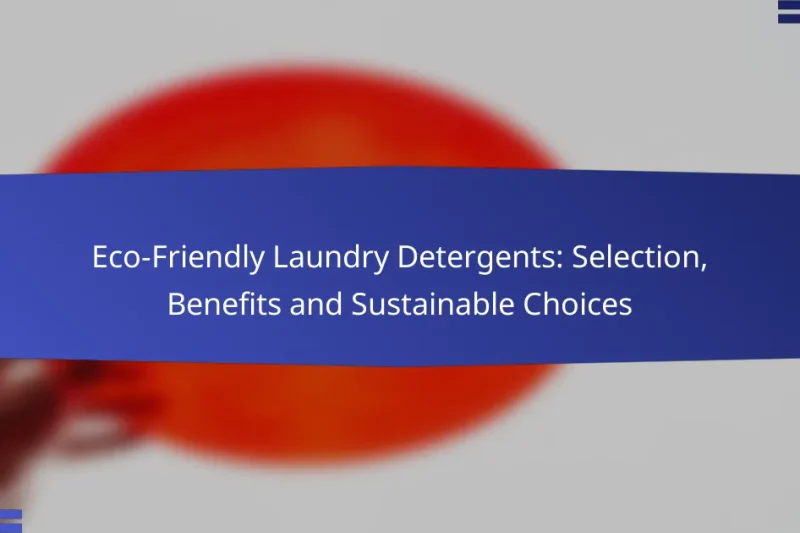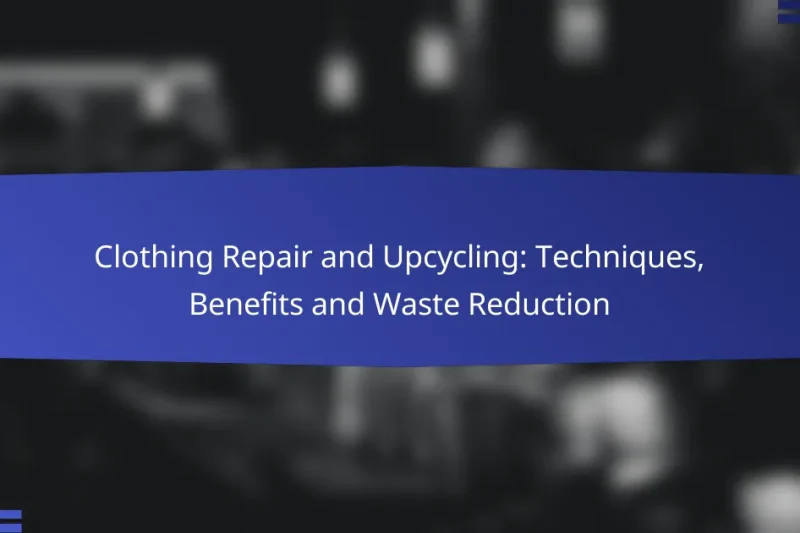Organic cotton clothing is not only a sustainable choice but also requires proper care to ensure … Organic Cotton Clothing: Proper Care Methods and Consumer TipsRead more
Caring for Sustainable Clothing
Caring for sustainable clothing is essential to preserve its eco-friendly qualities and extend its lifespan. By implementing specific washing, drying, and storage practices, you can minimize environmental impact while keeping your garments in excellent condition. Simple guidelines can make a significant difference in maintaining the integrity of your sustainable wardrobe.
Sustainable Fabrics: Washing Techniques, Lifespan Extension and Care
Proper care and washing techniques are crucial for maintaining the quality and longevity of sustainable fabrics … Sustainable Fabrics: Washing Techniques, Lifespan Extension and CareRead more
Clothing Swaps: Benefits, Community Engagement and Sustainable Wardrobe Maintenance
Clothing swaps are an innovative way to promote sustainable fashion by allowing individuals to exchange garments, … Clothing Swaps: Benefits, Community Engagement and Sustainable Wardrobe MaintenanceRead more
Eco-Friendly Laundry Detergents: Selection, Benefits and Sustainable Choices
Eco-friendly laundry detergents provide a powerful cleaning solution while prioritizing sustainability and environmental health. Formulated with … Eco-Friendly Laundry Detergents: Selection, Benefits and Sustainable ChoicesRead more
Clothing Repair and Upcycling: Techniques, Benefits and Waste Reduction
Clothing repair and upcycling are essential practices that not only extend the life of garments but … Clothing Repair and Upcycling: Techniques, Benefits and Waste ReductionRead more
Dry Cleaning vs. Home Washing: Environmental Impact and Considerations
The choice between dry cleaning and home washing carries significant environmental implications. Dry cleaning relies on … Dry Cleaning vs. Home Washing: Environmental Impact and ConsiderationsRead more
How to wash sustainable clothing?
Washing sustainable clothing requires specific care to maintain its eco-friendly qualities. By following a few simple guidelines, you can help extend the life of your garments while minimizing environmental impact.
Use cold water
Washing clothes in cold water is one of the most effective ways to conserve energy and protect fabric integrity. Cold water reduces the risk of shrinkage and fading, which is particularly important for sustainable materials that may be more delicate.
Consider setting your washing machine to a cold cycle, typically around 20-30 degrees Celsius (68-86 degrees Fahrenheit). This temperature is effective for most fabrics while being gentle on the environment.
Choose eco-friendly detergents
Using eco-friendly detergents is crucial for washing sustainable clothing. These detergents are formulated without harsh chemicals, making them safer for both the environment and your skin.
Look for products labeled as biodegradable or free from phosphates and synthetic fragrances. Many brands offer concentrated versions that require less packaging and are more efficient in use.
Avoid fabric softeners
Fabric softeners can coat fibers, reducing breathability and moisture-wicking properties, which are often essential for sustainable fabrics. Avoiding these products helps maintain the natural qualities of your clothing.
Instead of fabric softeners, consider using dryer balls or simply air drying your clothes to keep them soft without compromising their sustainability.
Air dry when possible
Air drying is a sustainable alternative to using a dryer, significantly reducing energy consumption. Hanging clothes to dry can also help prevent wear and tear, extending the life of your garments.
Whenever feasible, hang your clothing outside or in a well-ventilated area. If you must use a dryer, opt for a low heat setting to minimize damage and energy use.
What are the best practices for drying sustainable clothing?
The best practices for drying sustainable clothing focus on preserving fabric integrity and minimizing environmental impact. Key methods include line drying, using low heat settings, and avoiding tumble drying whenever possible.
Line drying
Line drying is one of the most eco-friendly methods for drying sustainable clothing. Hanging garments outdoors or indoors allows air to circulate freely, which helps maintain the fabric’s shape and color while reducing energy consumption.
When line drying, choose a shaded area to prevent fading caused by direct sunlight. Ensure that clothes are spaced adequately to allow for proper airflow, which speeds up the drying process and prevents musty odors.
Use a low heat setting
If you must use a dryer, opt for a low heat setting to protect your sustainable clothing. High temperatures can damage fibers, leading to shrinkage and reduced lifespan.
Using a low heat setting not only preserves the quality of the fabric but also saves energy. Consider drying clothes in batches to maximize efficiency and reduce overall drying time.
Avoid tumble drying
Avoiding tumble drying is crucial for maintaining the integrity of sustainable clothing. Tumble dryers can cause excessive wear and tear, leading to pilling and fading.
Instead, explore alternatives such as air drying or using a drying rack. These methods are gentler on fabrics and contribute to a more sustainable laundry routine.
How to store sustainable clothing properly?
Proper storage of sustainable clothing is essential to maintain its quality and longevity. By following a few key practices, you can protect your garments from damage and ensure they remain in good condition for years to come.
Use breathable garment bags
Breathable garment bags are ideal for storing sustainable clothing as they allow air circulation while protecting against dust and pests. Look for bags made from natural fibers like cotton or linen, which can help prevent moisture buildup that may lead to mold or mildew.
When using garment bags, ensure they are not overly tight, as this can cause creasing or damage to the fabric. Consider labeling bags to easily identify contents, especially if you have multiple items stored away.
Avoid plastic storage
Plastic storage can trap moisture and create an environment conducive to mold and mildew, which can damage sustainable clothing. Instead, opt for storage solutions made from natural materials that allow for better air circulation.
If you must use plastic, choose breathable options like mesh containers. Always ensure that garments are clean and completely dry before storing to minimize the risk of moisture-related issues.
Keep in a cool, dark place
Storing sustainable clothing in a cool, dark place helps prevent fading and deterioration caused by light and heat. Ideal storage temperatures are typically between 15-20°C (59-68°F), which can help maintain fabric integrity over time.
Avoid areas with high humidity or direct sunlight, such as attics or basements. Consider using a closet or a dedicated storage box placed in a climate-controlled environment for optimal protection.
What are the benefits of caring for sustainable clothing?
Caring for sustainable clothing offers numerous advantages, including extending the life of garments, minimizing environmental harm, and preserving the quality of fabrics. By adopting proper care practices, consumers can contribute to a more sustainable fashion industry while enjoying their clothing for longer periods.
Prolongs lifespan
Proper care techniques can significantly prolong the lifespan of sustainable clothing. Washing garments in cold water, using gentle detergents, and air drying can help maintain their shape and color. Avoiding frequent washing and opting for spot cleaning when possible can also reduce wear and tear.
Consider implementing a rotation system for your wardrobe to minimize the use of any single item. This practice not only extends the life of each piece but also encourages a more mindful approach to clothing consumption.
Reduces environmental impact
Caring for sustainable clothing can lead to a lower environmental impact by reducing the frequency of replacements. Each time a garment is washed, microfibers can be released into waterways, contributing to pollution. By washing less frequently and using a microfiber filter, you can help mitigate this issue.
Additionally, choosing to repair rather than discard damaged items can significantly decrease waste. Simple sewing skills or local repair services can breathe new life into clothing that might otherwise end up in landfills.
Maintains fabric integrity
Maintaining the integrity of fabrics is crucial for sustainable clothing. Different materials require specific care methods; for instance, wool should be hand washed or dry cleaned, while cotton can typically withstand machine washing. Always check care labels for guidance on the best practices for each garment.
Using the right storage techniques, such as keeping clothes in breathable bags and avoiding direct sunlight, can also help preserve fabric quality. This attention to detail ensures that your sustainable clothing remains in excellent condition for years to come.
How to repair sustainable clothing?
Repairing sustainable clothing is essential for extending its life and reducing waste. Simple techniques like sewing, patching, and replacing buttons can help maintain your garments while promoting eco-friendly practices.
Sewing small tears
Sewing small tears is a straightforward way to fix your clothing. Use a needle and thread that matches the fabric color to make the repair less noticeable. For best results, use a simple running stitch or a backstitch for added strength.
Before you start, ensure the fabric is clean and dry. If you’re unsure about your sewing skills, practice on a scrap piece of fabric first. This will help you gain confidence and improve your technique.
Using patches
Patching is an effective method for repairing larger holes or worn areas in clothing. You can choose from fabric patches that match your garment or go for a contrasting design for a trendy look. Iron-on patches are particularly easy to apply and provide a durable fix.
When applying a patch, make sure to position it over the damaged area securely. If you’re sewing it on, use a zigzag stitch around the edges to prevent fraying. This technique not only repairs but can also add a unique touch to your clothing.
Replacing buttons
Replacing buttons is a simple yet impactful repair that can refresh your clothing. Gather a needle, thread, and a replacement button that matches or complements your garment. Ensure the thread is strong enough to withstand regular use.
When sewing on a button, start by placing it in the desired position and securing it with a few stitches. For added durability, consider using a shank button, which allows for more flexibility in the fabric. This small change can significantly enhance the longevity of your clothing.
What are the eco-friendly laundry alternatives?
Eco-friendly laundry alternatives include methods and products that reduce environmental impact while cleaning clothes. These options often use natural ingredients, conserve water, and minimize energy consumption.
Natural Detergents
Natural detergents are made from plant-based ingredients and are free from synthetic chemicals. They are biodegradable and often come in minimal packaging, reducing waste. Look for brands that are certified organic or have eco-labels to ensure their environmental claims.
When using natural detergents, consider adjusting the amount based on your load size and soil level. Generally, using less than the recommended amount can still yield effective cleaning while being gentler on the environment.
Cold Water Washing
Washing clothes in cold water significantly reduces energy consumption compared to hot water. Most modern detergents are formulated to work effectively in cold temperatures, making it a practical choice for everyday laundry.
To maximize the benefits of cold water washing, sort your laundry by fabric type and color. This prevents damage and color bleeding, ensuring your clothes remain in good condition while saving energy.
Air Drying
Air drying clothes is an energy-efficient alternative to using a dryer. It not only saves electricity but also extends the lifespan of your garments by reducing wear and tear from high heat.
When air drying, hang clothes in a well-ventilated area to speed up the drying process. Consider using a drying rack indoors during colder months or a clothesline outdoors when weather permits.
Eco-Friendly Fabric Softeners
Eco-friendly fabric softeners are made from natural ingredients and avoid harmful chemicals found in conventional products. They help reduce static and soften fabrics without negatively impacting the environment.
To make your own fabric softener, mix equal parts of white vinegar and water in a spray bottle. This solution can be added during the rinse cycle and is a cost-effective alternative to commercial softeners.





